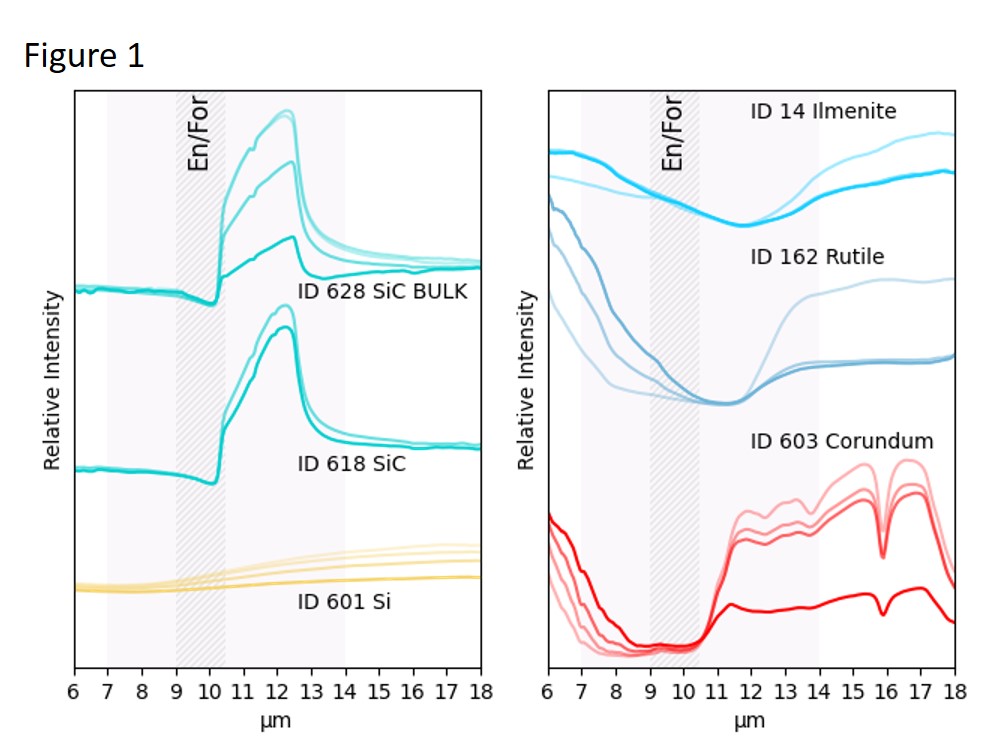Oxides and Reduced Phases in the Mid-IR: Data for the BepiColombo Mission to Mercury
- 1Universität Münster, Institut für Planetologie, Germany (morlok1970@icloud.com)
- 2Universität Münster, Institut für Mineralogie
- 3Institute for Planetary Research
Introduction: The MERTIS (MErcury Radiometer and Thermal Infrared Spectrometer) onboard of the BepiColombo ESA/JAXA mission to Mercury is a mid-infrared instrument that will allow mapping the hermean surface from 7 µm to 14 µm [1,2]. After arrival in 2025, a database for the interpretation of the data is needed. As part of this effort, we have studied rock samples like impact rocks and meteorites [e.g,. 3]. A second field of interest are analogs synthesized based on data by MESSENGER [e.g., 4].
Based on recent modeling of the oxidation state of the hermean surface, a highly reducing environment can be expected [5,6]. Likewise past volcanism or impact experiments suggest the presence of extremely reduced phases, e.g., Si-metal (e.g, 7, 8]). This implies that in addition to common minerals (pyroxene, plagioclase), also oxides (corundum, spinel, periclase), metallic phases, halides, and reduced variations e.g. of olivine (Ca-olivine Larnite) are possible. As part of our database project, we cover this type mineral phases.
Samples and Techniques: We characterized the materials first with EMPA. Samples were ground and sieved into grain four size fractions (<25 µm, 25µm-63 µm, 63µm-125 µm and 125µm-250 µm). Mid-infrared reflectance spectra were obtained from 2-18 µm with a Vertex70v at the IRIS lab at the Institut for Planetologie, University of Münster. Always 512 scans were averaged, a diffuse gold standard was applied for calibration.
Results: A strong Reststrahlenband (RB) between 12.2 µm and 12.5 µm is typical for SiC. The Christiansen Feature (CF), a characteristic low-point, is at 10.1 µm.
No features are seen in metallic Si. The spectrum is a continuum in the mid-infrared that increases towards longer wavelengths.
The spectra for oxides are fundamentally different: They exhibit a trough-like low in the very range where silicates have their characteristic RBs. For ilmenite, the low is from 11.7 µm to 11.9 µm, for rutile from 11.1 µm to 11.3 µm and corundum shows a broad low at from 8.4 µm -10.0 µm. These low-points are also the CF. In addition, corundum exhibits absorption-like bands from 12.4 µm to 15.9 µm.
Summary & Conclusions: There are clear differences between silicates and oxides: The broad low from 8.4 µm – 11.4 µm is where silicates have their RBs. This would give even low abundances of oxides a big influence on the general spectral shape. Refractory SiC has a spectrum similar to silicates, the CF at 10.1 µm is at clearly longer wavelength compared to silicates. Similar, the broad ‘low’ of the oxides would shift the CF to longer wavelengths.
References: [1] Hiesinger et al. (2020) Space Sci Rev. 216, 8, id.147. [2] Benkhoff, J. et al. (2021) Space Sci Rev. 217, 8, id.90. [3] Morlok et al. (2016) Icarus 264, 352-368 [4] Morlok et al. (2021) Icarus 361, [5] McCubbin et al. (2017) JGR Planets 122, 2053-2076 [6] vander Kaaden et al. (2017) Icarus 285, 155-168 [7] Stojic et al. (2022) EPSC 2022, Abstract No. EPSC2022-813. [8] Iacovino et al. (2023). Earth and Planetary Science Letters, 602, 117908.
Fig.1: (Left) Reflectance mid-infrared spectra for SiC (Top) and metallic Si (Bottom). The metallic Si shows features in the MERTIS range (dotted area, 7-14 µm). SiC on the other hand exhibits a RB from 12.2 µm to 12.5 µm. (Right) Oxides show a similar shape, a trough-like low in the MERTIS range. The CF for oxides is shifted compared to silicates.
Hatched area: characteristic bands for typical silicates enstatite (En) and forsterite (For), which tend to form in the low area of the oxides. Shaded area: range of the MERTIS instrument.
How to cite: Morlok, A., Weber, I., Reitze, M. P., Stojic, A. N., Klemme, S., Pasckert, J. H., Bauch, K. E., Hiesinger, H., and Helbert, J.: Oxides and Reduced Phases in the Mid-IR: Data for the BepiColombo Mission to Mercury , Europlanet Science Congress 2024, Berlin, Germany, 8–13 Sep 2024, EPSC2024-215, https://doi.org/10.5194/epsc2024-215, 2024.